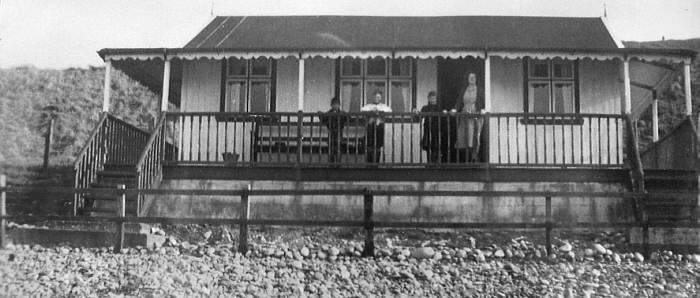

WAVERLEY AND THE GRAHAMS
Early in September 2006, I was treated to a splendid afternoon, sitting outside a bungalow on Braystones shore, listening to two men who have both been key figures in the community life of the beach for many years. One was John Henson, whose contributions get several pages on this website, the other, our host at 'Waverley', was Peter Graham, who hasn't lived there as long as John (he bought the bungalow in 1988), but has family connections going right back to the early days.
 The lad on the bottom step in this 1920's view at 'Spray Garth', a few doors south of 'Waverley', is Peter's wife's grandfather, Tom Herdman, and facing each other at the top are his parents, Isaac and Hannah (Peter apologises for the state of the two other boys, who were victims of an unsympathetic bit of digital reconstruction of the damaged original picture). In his later years, Tom was a good friend and fishing companion of Mr Henson- who regrets one small argument they had over whether it was a good idea to make a permanent vehicular access track along the beach. Tom was worried that it would damage the shore's wonderful atmosphere of seclusion, and in retrospect, despite all the advantages for the emergency services etc., John admits that Tom was right.
The lad on the bottom step in this 1920's view at 'Spray Garth', a few doors south of 'Waverley', is Peter's wife's grandfather, Tom Herdman, and facing each other at the top are his parents, Isaac and Hannah (Peter apologises for the state of the two other boys, who were victims of an unsympathetic bit of digital reconstruction of the damaged original picture). In his later years, Tom was a good friend and fishing companion of Mr Henson- who regrets one small argument they had over whether it was a good idea to make a permanent vehicular access track along the beach. Tom was worried that it would damage the shore's wonderful atmosphere of seclusion, and in retrospect, despite all the advantages for the emergency services etc., John admits that Tom was right.
Peter remembers that the track stopped near Waverley when he began his life as a beach-dweller; hundreds of tons of stone had to be brought in to establish a firm base to continue it northwards. Today it's pretty stable, merely requiring shingle scattered over it by winter storms to be cleared off in most years, though really bad gales can do serious damage.
'Waverley' today is a much more substantial structure than it used to be, for Mr & Mrs Graham rebuilt it in 1999-2000. The most difficult aspect of the project seems not to have been the construction work, but the struggle against the Council Planning Department. Peter spent days in the local Record Office gathering evidence to prove that planning restrictions the Council sought to impose were wrong- even to the extent of having to demonstrate that there had been regular occupation of the building over several decades.
Peter takes a keen interest in the general welfare of the beach (at the time of our conversation, he was investigating the worrying possibility that fire-engines may not be able to use the redesigned level crossing at Braystones Station). Another topic which used to concern him was the water supply: most people used to rely on spring water until 2001, but "spring" is a slightly false term. Some of the springs are so close to the surface of the fields above, that if you took a sample of water to be tested it might very well be perfectly wholesome, but an application of chemicals by the farmer the next day could affect the quality very quickly.
When the Grahams arrived at 'Waverley' they found that the previous owners, the Bowes's- owners of the boring firm at Egremont- had bored a hole some 15 metres deep behind the bungalow; sadly the water at the bottom was not very appetising. Incidentally, Peter also found a mysterious culvert under the railway embankment, apparently serving no purpose. Later, he did most of the work arranging the provision of piped water for this stretch of shore- it took about 18 months of correspondence. John reckons when the spring water's good, it's very good indeed, and he still has one tap connected to a 6000-gallon water-tank fed by a spring below the railway line, but nowadays the tank supply is mostly used for flushing toilets for the Hensons and their neighbours, saving metered water. [A 2003 report on the ways people were exposed to the environment in areas close to the Sellafield nuclear plant claimed that bungalows south of the station were still getting their drinking water from a pipe sticking out of the dunes, which was a bit unfair- it actually sticks out of the railway embankment]
